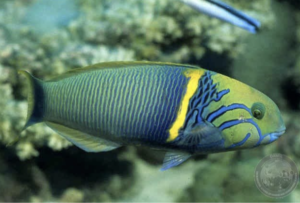Wrasse Species
 The wrasse is a bony fish belonging to the Perciformes order and Labridae family. There are over 500 different species of wrasse, including at least 81 genera and 9 different tribes or groups. They are temperate and tropical ocean fish found in the Atlantic, Pacific and Indian Ocean. They live among coral reefs and rocky shores. Wrasse come in a variety of colors that may reflect their age or sex, including white, orange, blue, purple, yellow, green and gray, often with a stripe or bar against a solid background color. Their scales are smooth, their body is elongated and relatively slender, and their dorsal and anal fins are long. They are known for their protractile mouths and named after their thick, protruding lips.
The wrasse is a bony fish belonging to the Perciformes order and Labridae family. There are over 500 different species of wrasse, including at least 81 genera and 9 different tribes or groups. They are temperate and tropical ocean fish found in the Atlantic, Pacific and Indian Ocean. They live among coral reefs and rocky shores. Wrasse come in a variety of colors that may reflect their age or sex, including white, orange, blue, purple, yellow, green and gray, often with a stripe or bar against a solid background color. Their scales are smooth, their body is elongated and relatively slender, and their dorsal and anal fins are long. They are known for their protractile mouths and named after their thick, protruding lips.
Their family name comes from the Latin word labrum meaning “lips or edge.” Their teeth are strong with at least two protruding canines at the front. Species size varies widely between 2 in and 7 ft as an adult. Most have a lifespan between 3-10 years, but some species may life up to 30 years. Wrasses are diurnal, hunting during the day and being relatively inactive at night. They are carnivorous with a diet of small fish and invertebrates. Some small wrasse, like blueheads, will act as cleaner fish consuming external parasites for larger species of fish, groupers and eels. Lionfish, sharks and barracuda are common predators of wrasse. Most species are solitary in the wild and even aggressive towards newly introduce fish in aquariums. They are broadcast spawners that can have up to 1,000 eggs at a time. Some wrasse species will remain one sex through their entire life, but many are protogynous hermaphrodites that function as females before transforming into males. Some species will have primary males or even sex-reversed females.
The majority of wrasses pose no great commercial importance to humans, and most species are considered of least concern for conservation. However, one the most famous wrasse, the humphead wrasse, is listed as endangered by the International Union for Conservation of Nature (IUCN), a species of concern by the U.S. National Marine Fisheries Service and on the CITES’ Appendix II. These are one of the largest wrasse species and reef fish at 7 ft and 420 lbs. They serve an important ecological role by consuming animals that eat hard coral, such as the crown-of-thorns starfish. They are both a luxury dish in Asia and a popular fish for aquarium trade. Overfishing is their biggest threat, and the population has difficulty recovering due to slow reproductive rates and diminishing spawning sites. Conservation efforts include encouraging aquarium breeding programs and buying back these fish to return to their natural environment.
